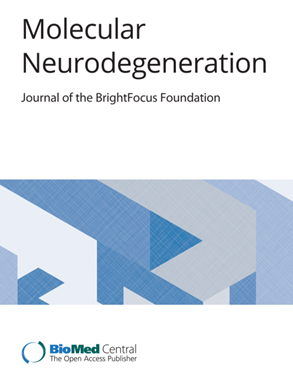在阿尔茨海默病模型中,光遗传学靶向gaba能神经元的睡眠恢复可重编程小胶质细胞并改善病理表型
IF 14.9
1区 医学
Q1 NEUROSCIENCES
引用次数: 0
摘要
阿尔茨海默病(AD)患者表现出记忆中断和深度睡眠障碍,包括深度非快速眼动(NREM)睡眠中断。慢波活动(SWA)是非快速眼动睡眠的主要恢复特征,对记忆巩固很重要。我们建立了一个小鼠模型,在APPswe/PS1dE9 (APP)淀粉样变存在时,gaba能中间神经元可以被靶向,APP- gad - cre小鼠。采用脑电图(EEG) /肌电(EMG)遥测系统监测睡眠中断。利用通道视紫红质-2 (ChR2)对前皮层gaba能中间神经元进行光遗传刺激,使我们能够研究gaba能中间神经元在睡眠缺陷中的作用。我们还研究了光遗传刺激对淀粉样斑块、神经元钙以及睡眠依赖性记忆巩固的影响。此外,使用共聚焦显微镜和流式细胞术评估小胶质细胞的形态特征和功能。最后,我们在光遗传刺激期间进行睡眠剥夺,以研究睡眠恢复是否对减缓AD的进展是必要的。与非转基因(NTG) NTG- gad - cre小鼠相比,APP-GAD-Cre小鼠在睡眠结构上表现出损伤,包括NREM睡眠时间减少、δ波功率下降和睡眠碎片化增加。光遗传刺激皮质gaba能中间神经元增加SWA并挽救APP-GAD-Cre动物的睡眠障碍。此外,它通过减少淀粉样蛋白沉积,使神经元钙稳态正常化和改善记忆功能来减缓AD的进展。这些变化伴随着小胶质细胞数量增加和形态转变,吞噬标志物表达升高,小胶质细胞吞噬淀粉样蛋白(a β)活性增强。睡眠是APP-GAD-Cre小鼠病理生理表型改善的必要条件。总之,我们的研究表明,光遗传学靶向gaba能中间神经元可以拯救睡眠,然后通过增加AD小鼠模型中小胶质细胞对Aβ的清除来改善神经病理和行为缺陷。本文章由计算机程序翻译,如有差异,请以英文原文为准。
Sleep restoration by optogenetic targeting of GABAergic neurons reprograms microglia and ameliorates pathological phenotypes in an Alzheimer’s disease model
Alzheimer’s disease (AD) patients exhibit memory disruptions and profound sleep disturbances, including disruption of deep non-rapid eye movement (NREM) sleep. Slow-wave activity (SWA) is a major restorative feature of NREM sleep and is important for memory consolidation. We generated a mouse model where GABAergic interneurons could be targeted in the presence of APPswe/PS1dE9 (APP) amyloidosis, APP-GAD-Cre mice. An electroencephalography (EEG) / electromyography (EMG) telemetry system was used to monitor sleep disruptions in these animals. Optogenetic stimulation of GABAergic interneurons in the anterior cortex targeted with channelrhodopsin-2 (ChR2) allowed us to examine the role GABAergic interneurons play in sleep deficits. We also examined the effect of optogenetic stimulation on amyloid plaques, neuronal calcium as well as sleep-dependent memory consolidation. In addition, microglial morphological features and functions were assessed using confocal microscopy and flow cytometry. Finally, we performed sleep deprivation during optogenetic stimulation to investigate whether sleep restoration was necessary to slow AD progression. APP-GAD-Cre mice exhibited impairments in sleep architecture including decreased time spent in NREM sleep, decreased delta power, and increased sleep fragmentation compared to nontransgenic (NTG) NTG-GAD-Cre mice. Optogenetic stimulation of cortical GABAergic interneurons increased SWA and rescued sleep impairments in APP-GAD-Cre animals. Furthermore, it slowed AD progression by reducing amyloid deposition, normalizing neuronal calcium homeostasis, and improving memory function. These changes were accompanied by increased numbers and a morphological transformation of microglia, elevated phagocytic marker expression, and enhanced amyloid β (Aβ) phagocytic activity of microglia. Sleep was necessary for amelioration of pathophysiological phenotypes in APP-GAD-Cre mice. In summary, our study shows that optogenetic targeting of GABAergic interneurons rescues sleep, which then ameliorates neuropathological as well as behavioral deficits by increasing clearance of Aβ by microglia in an AD mouse model.
求助全文
通过发布文献求助,成功后即可免费获取论文全文。
去求助
来源期刊

Molecular Neurodegeneration
医学-神经科学
CiteScore
23.00
自引率
4.60%
发文量
78
审稿时长
6-12 weeks
期刊介绍:
Molecular Neurodegeneration, an open-access, peer-reviewed journal, comprehensively covers neurodegeneration research at the molecular and cellular levels.
Neurodegenerative diseases, such as Alzheimer's, Parkinson's, Huntington's, and prion diseases, fall under its purview. These disorders, often linked to advanced aging and characterized by varying degrees of dementia, pose a significant public health concern with the growing aging population. Recent strides in understanding the molecular and cellular mechanisms of these neurodegenerative disorders offer valuable insights into their pathogenesis.
 求助内容:
求助内容: 应助结果提醒方式:
应助结果提醒方式:


